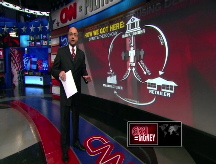Long-term Treasurys tumble
Treasurys sell off for the second day as investors seek out higher returns and Obama pitches his stimulus plan to Congress.
NEW YORK (CNNMoney.com) -- Long-term government debt prices tumbled for the second session in a row Monday as investors shifted into riskier bonds and as President-elect Barack Obama pitched his stimulus package to both houses of Congress.
The 30-year bond plummeted more than 5 points in afternoon trade Monday, before recovering slightly, and the yield topped 3%. Prices and yields move in opposite direction. Treasurys were also reacting to a jolt of supply from a slew of auctions designed to help fund the government's stimulus programs.
In 2008, Treasury prices surged to record highs, with yields setting record lows as investors headed for the bunkers, willing to sacrifice a profitable return on their investment for the safety of Uncle Sam holding their assets.
The yield on the three-month Treasury note hovered around zero for weeks toward the end of the year.
But as the new year rolled over and investors worried that Treasurys would continue to offer little or no returns, long-term government debt prices started to decline. Treasurys started the new year on a down note, which one analyst said was actually a healthy shift.
Investors were starting to show some risk tolerance by snapping up municipal and safe corporate bonds, which offer higher returns, said William Larkin, portfolio manager at Cabot Money Management.
"People are starting to make the bet that we are coming off the bottom," said Larkin. He warned, however, that with ominous employment data due out at the end of the week, "it is one of those things where only time will tell."
And with the economy expected to get a boost from Obama's stimulus plan and stocks at bargain prices, demand for the safety of Treasurys could decelerate further.
"The fiscal stimulus package, which now includes tax cuts, may indeed provide some stimulus for the economy, which is a negative for bonds because it takes away the flight to quality bit," said Mary Ann Hurley, vice president of fixed income trading at D.A. Davidson.
Obama laid out the framework for his stimulus plan in his weekly radio address on Saturday. The American Recovery and Reinvestment Plan focuses on rebuilding infrastructure, creating jobs, and upping renewable energy production.
Supply on tap: The government has been bringing a record supply of Treasurys to the market, and that flood does not show any signs of lessening, especially with Obama's costly stimulus plan in the pipelines.
"This growing fiscal stimulus plan is also going to increase budget deficits," said Hurley. When the government gets into debt, it will sell government Treasurys as a way of raising capital. "And that is in conjunction with a heavy calendar of Treasury supply to bid on this week," said Hurley.
The specifics of Obama's plan were still up in the air. "It all comes down to what type of package do we actually get, when it is enacted, when does money get into consumer's pockets," added Hurley.
Another analyst echoed the sentiment. "from a spending and a tax break standpoint," said Larkin, the Obama plan, "is going drive up Treasury auctions." And a jolt of supply means a lower prices and higher yields.
The Treasury auctioned $26 billion worth of 91-day, or 13-week, bills and $27 billion worth of 182-day, or 26-week, bills Monday.
Tuesday, the Treasury was set to auction $8 billion worth of TIPS, or Treasury Inflation-Protected Securities. The principal of a TIPS fluctuates with inflation. Also, the Treasury was scheduled to auction $24 billion worth of 28-day, or 4-week, bills on Tuesday.
Wednesday, the government was set to auction $35 billion worth of 70-day cash management bills, yet another form of short-term government debt.
Finally, the Treasury was scheduled to auction $30 billion worth of 3-year notes Wednesday and it was re-opening $16 billion worth of 10-year notes in auction on Thursday.
Debt prices: The benchmark 10-year fell 27/32 to 111 7/32 and its yield rose to 2.46% from 2.36% late Friday. Bond prices and yields move in opposite directions.
The 30-year bond sunk 4 31/32 to 128 30/32 and its yield rose to 3.01% from 2.78% late Friday.
Meanwhile, the 2-year note edged up 4/32 to 100 6/32 and its yield dipped to 0.79% from 0.85% Friday.
The short-term 3-month Treasury bill yield 0.09%, even with Friday. The 3-month Treasury bill is considered a gauge of confidence because investors shuffle funds in and out of the note as they assess the risk of the marketplace.
Lending rates: Bank-to-bank lending rates have come down substantially from the record highs reached during the peak of the credit crisis.
The 3-month Libor rose to 1.42% Monday, up slightly from 1.41% Friday, while the overnight Libor rate held at 0.12%, unchanged from Friday, according to the British Banker's Association.
Libor - the London Interbank Offered Rate - is a daily average of rates 16 different banks charge each other to lend money in London. It is used to calculate adjustable-rate mortgages. More than $350 billion in assets are tied to Libor.
Two credit market gauges were little changed.
The "TED spread," a measure of banks' willingness to lend was 1.33 percentage points, unchanged from Friday. The lower the TED spread, the more willing investors are to take risks. Along with bank-to-bank lending rates, the TED spread surged when the credit crisis took hold in late September.
Another indicator, the Libor-OIS spread, narrowed slightly to 1.23 percentage points from 1.29 percentage points Friday. The Libor-OIS spread measures how much cash is available for lending between banks, and is used for determining lending rates. The narrower the spread, the more cash is available for lending. ![]()







